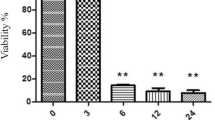Summary
The protective effects of in vitro cultivated calculus bovis (ICCB) on the cerebral and myocardial cells in hypoxic mice and the mechanism were examined. In one group, mice were intragastrically (i.g.) given ICCB for 15 days and then they were subjected to acute cerebral ischemia by decapitation, and then the panting time was recorded. In the other group, 12 min after exposure to hypoxia, mice was administered the ICCB i.g. for 5 days, and then the blood serum and tissues of brain, heart, liver were harvested and examined for SOD, GSH-px and T-AOC activity and content of MDA. The tissues of brain and heart were observed electron-microscopically for ultrastructural changes. The corpus striatum and hippocampus of brain were collected and examined for content of dopamine (DA) and norepinephrine (NE). The ultrastrural examination showed that the pathological change in brain and heart in the ICCB group was very slight, while abnormal changes in the control group were obviously more serious. ICCB significantly prolonged the panting time of the hypoxic mice (P<0.001), increased the activity of SOD, GSH-px, T-AOC in serum and tissues of brain, liver, heart and elevated the content of DA and NE. ICCB also pronouncedly reduced content of MDA in serum and tissues of brain, heart and liver. Significant differences in these parameters were noted between ICCB group and controls. It is concluded that ICCB can exert protective effect on the cells of brain and myocardium by enhancing the tolerance of the tissues to hypoxia and the body’s ability to remove free radicals and regulating the neurotransmitters.
Similar content being viewed by others
References
Cai H J, Qiu F Z. Studies on the pharmacy of in-vitro cultivated calculus bovis. Chin J Natural Med (Chinese), 2004,2(6):335–338
Hirata M, Itoh M, Tsuchida A et al. Cholecystokinin receptor antagonist, loxiglumide, inhibits invasiveness of human pancreatic cancer cell lines. FEBS Lett, 1996,383(3):241–244
Hirata M, Tsuchida A, Iwao T et al. Cholecystokinin regulates the invasiveness of human pancreatic cancer cell lines via protein kinase C pathway. Int J Oncol, 1999,14(6):1129–1135
Aly A, Shulkes A, Baldwin G S. Gastrins, cholecystokinins and gastrointestinal cancer. Biochim Biophys Acta, 2004,1704(1):1–10
Michaud D S. Epidemiology of pancreatic cancer. Minerva Chir, 2004,59(2):99–111
Yeo C J. Pancreatic cancer: 1998 update. J Am Coll Surg, 1998,187(4):429–442
Tighe H, Corr M, Roman M et al. Gene vaccination: plasmid DNA is more than just a blueprint. Immunol Today, 1998,19(2):89–97
Bergman P J, McKnight J, Novosad A et al. Long-term survival of dogs with advanced malignant melanoma after DNA vaccination with xenogeneic human tyrosinase: a phase I trial. Clin Cancer Res, 2003,9(4):1284–1290
Weber L W, Bowne W B, Wolchok J D. Tumor immunity and autoimmunity induced by immunization with homologous DNA. J Clin Invest, 1998, 102(6):1258–1264
Author information
Authors and Affiliations
Corresponding author
Rights and permissions
About this article
Cite this article
Cai, H., Guang, Y., Liu, L. et al. The protective effects of in vitro cultivated calculus bovis on the cerebral and myocardial cells in hypoxic mice. J. Huazhong Univ. Sci. Technol. [Med. Sci.] 27, 635–638 (2007). https://doi.org/10.1007/s11596-007-0603-2
Received:
Issue Date:
DOI: https://doi.org/10.1007/s11596-007-0603-2




